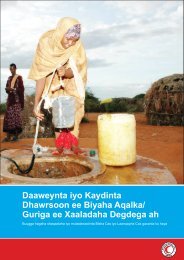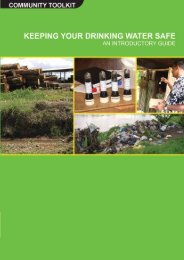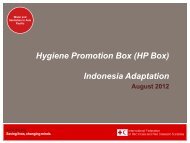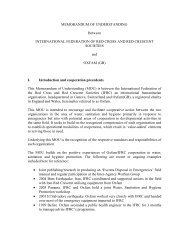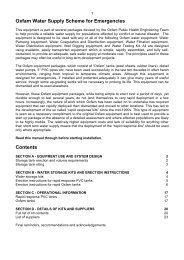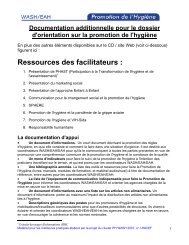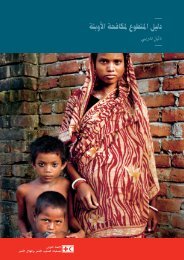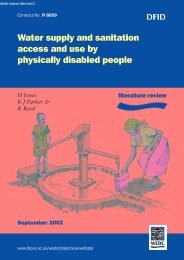Rosensweig, Fred <strong>and</strong> Chris McGahey (2002). ‘<strong>Hygiene</strong> Improvement Framework.’Summary Report E-Conference March 1-31, 2002. Arlington, VA, USA: EnvironmentalHealth Projecthttp://www.sanicon.net/titles/title.php3?titleno=61Supplementing observations <strong>and</strong> provocative questions from an E-conference , with casereports of water <strong>and</strong> sanitation projects with hygiene promotion.Sawyer, Ron M. Simpson-Hébert, S. Wood (1998). PHAST Step-by-Step Guide: aparticipatory approach for the control of diarrhoeal disease.WHO, Switzerl<strong>and</strong>, Geneva, (WHO/EOS/98.3)http://www.who.int/docstore/water_sanitation_health/Environmental_sanit/PHAST/phast96-11/96-11index.htmIncludes instructions for helping communities improve hygiene behaviour, prevent cholera<strong>and</strong> other diarrhoeal diseases, <strong>and</strong> manage their own water <strong>and</strong> sanitation facilities.Addressed to facilitators working in the community, the manual uses the Participatory<strong>Hygiene</strong> <strong>and</strong> <strong>Sanitation</strong> Transformation, or PHAST, approach, an exciting newmethodology, which relies on locally prepared visual “toolkits” to stimulate communityenthusiasm <strong>and</strong> participation. Recommended materials <strong>and</strong> activities were extensively fieldtested in four African countries.Shordt, Kathleen (2003). ‘Sustaining <strong>Hygiene</strong> Behaviours.’ Loughborough, UK:Loughborough University.http://www.lboro.ac.uk/well/resources/%23%23fact-sheets/fact-sheets-pdf/shb.pdfFactsheet produced for the WELL information programme. It gives findings from researchin the literature <strong>and</strong> an EU-financed six-country study on whether hygiene behaviours suchas h<strong>and</strong>washing <strong>and</strong> latrine use <strong>and</strong> upkeep continue after education finishes. <strong>Hygiene</strong>promotion was more essential than closeness <strong>and</strong> availability of water <strong>and</strong> behaviourslasted longer when promoted intensively over time with personal contacts. For 3 countrystudies see: www.newah.org.np/health%20education.htm (Nepal);http://www.netwas.org/newsletter/articles/2004/05/7 (Kenya) <strong>and</strong>http://www.irc.nl/page/4414 (Ghana).UNDP-World Bank <strong>Water</strong> <strong>and</strong> <strong>Sanitation</strong> Programme (1998). ‘Healthy communities.’English, 13 minutes/14 seconds. Price: US$ 20.00 A documentary about the Participatory<strong>Hygiene</strong> <strong>and</strong> <strong>Sanitation</strong> Transformation (PHAST) method, which has been pilot-tested inBotswana, Ethiopia, Kenya, Ug<strong>and</strong>a, <strong>and</strong> Zimbabwe. Available from: Communications,UNDP-World Bank <strong>Water</strong> <strong>and</strong> <strong>Sanitation</strong> Programme, mailto:info@wsp.org. No longeravailable free from internet.UNICEF (1999). ‘Towards better programming: a manual on hygiene promotion.’ (<strong>Water</strong>,Environment <strong>and</strong> <strong>Sanitation</strong> Technical Guidelines Series No. 6). New York: UNICEF(French <strong>and</strong> spanish versions pending) http://www.unicef.org/wes/files/hman.pdfThis manual presents methodologies to assist development workers in the promotion ofbehavioural change for safer hygiene practices, <strong>and</strong> to help make hygiene promotion50 <strong>Hygiene</strong> promotion
programmes more effective. The objective of the manual is to provide a tool that willcontribute towards a reduction in diarrhoeal diseases – one of the top three killer diseasesin developing countries – <strong>and</strong> thus a reduction in child mortality. The manual describes amethodology for bottom-up programming for hygiene promotion: first finding out whatpeople know about hygiene through formative research in people's knowledge <strong>and</strong>practices, <strong>and</strong> then combining this with state-of-the-art expert knowledge <strong>and</strong> appropriatecommunication strategies to develop effective <strong>and</strong> sustainable programming models. Themanual is accessible <strong>and</strong> jargon-free: its audience includes all professionals interested inthe area of hygiene promotion.<strong>Water</strong>keyn, Juliet (2003). ‘Cost-effectiveness of Health <strong>Promotion</strong>: Community HealthClubs.’ Paper presented at the 29th WEDC conference, Abuja, Nigeria.http://wedc.lboro.ac.uk/conferences/pdfs/29/<strong>Water</strong>keyn.pdf. In-depth study on costs <strong>and</strong>effectiveness of community health clubs for changing 50 hygiene practices. Report on 12of 16 observed practices show clubmembers practice more hygiene than the control group.The original paper (see case study) has more details <strong>and</strong> gives 27% higher adoption onclub promoted practices <strong>and</strong> 7% on practices already long promoted by the Ministry ofHealth. As the programme grew <strong>and</strong> If family members are included, cost per persondropped from USD 1 to 35 cents. It is not clear what has happened overall after projectcompletion <strong>and</strong> under the economic crisis.WHO (2005). ‘The Role of <strong>Hygiene</strong> Education’ (Factsheet 4.1). Geneva, Switzerl<strong>and</strong>,World Health Organization.http://www.who.int/water_sanitation_health/hygiene/emergencies/fs4_1.pdf<strong>Hygiene</strong> education helps improve health with <strong>and</strong> without improved facilities. Goodprogrammes make people aware, help prioritise <strong>and</strong> encourage self-action. Participationthrougout technology programmes is a condition, <strong>and</strong> has time <strong>and</strong> cooperationimplications. The use of participatory learning methods is recommended.WHO (2000). ‘Global <strong>Water</strong> Supply <strong>and</strong> <strong>Sanitation</strong> Assessment Report.’Geneva: World Health Organizationhttp://www.who.int/docstore/water_sanitation_health/Globassessment/GlobalTOC.html<strong>Hygiene</strong> promotion is increasingly important as rapidly increasing epidemiological evidencepoints to the importance of relatively small behavioural changes in protecting families fromfaecal-oral disease.WHO (1999). ‘Statistical Annex World Health Report 1999.’Geneva: World Health Organisation(http://www.who.int/whr/1999/en/)WHO (1996). ‘Participatory <strong>Hygiene</strong> <strong>and</strong> <strong>Sanitation</strong> Transformation: A new approach toworking with communities.’WHO, Switzerl<strong>and</strong>, Geneva (WHO/EOS/96.11)http://www.who.int/docstore/water_sanitation_health/Environmental_sanit/PHAST/phast96-11/96-11index.htm<strong>IRC</strong> <strong>International</strong> <strong>Water</strong> <strong>and</strong> <strong>Sanitation</strong> <strong>Centre</strong> 51
- Page 2: Please note that the TOPs are a web
- Page 7 and 8: 1. Hygiene PromotionWhat do you kno
- Page 9 and 10: 2. Why hygiene promotion matters2.1
- Page 11 and 12: • The costs of inaction can be hi
- Page 13 and 14: 3. Learning from experiences and re
- Page 15 and 16: • Hygiene Improvement Framework (
- Page 17 and 18: groups, and facilitators of partici
- Page 19 and 20: The diagrams are taken from McKee
- Page 21 and 22: • Food, utensils and food prepara
- Page 23 and 24: Guides for developing hygiene promo
- Page 25 and 26: • What may prevent this change in
- Page 27 and 28: areas, slabs and sanplats for latri
- Page 29 and 30: often not taken seriously and their
- Page 31 and 32: IIIIIIIVVInputsProcOutpEffectiImpae
- Page 33 and 34: over for reasons of hierarchy, e.g.
- Page 35 and 36: 5. Case studiesOn the following pag
- Page 37 and 38: The Project recognises the importan
- Page 39 and 40: almost all cases been exceeded, as
- Page 41 and 42: skin diseases, HIV/AIDS and tubercu
- Page 43 and 44: understanding of the importance of
- Page 45 and 46: councils (JSCs) are associations of
- Page 47 and 48: o through a schools programme, with
- Page 49 and 50: outputs and outcomes are focused mo
- Page 51: Harvey, Eric, Shadrack Dau, Alana P
- Page 55 and 56: scale. Comparison is on approach, l
- Page 57 and 58: Hygiene Behaviour Network, in Globa
- Page 59 and 60: WHO - World Health Organizationhttp
- Page 61 and 62: Tel: (703) 247-8730Fax: (703) 243-9
- Page 63 and 64: Manila, PhilippinesTel: +632 911-57
- Page 65 and 66: TOP Courses and conferencesCREPA, B
- Page 67 and 68: TOP ReferencesBoot, Marieke T. and
- Page 69 and 70: TOP Quiz on Hygiene PromotionTry it
- Page 71 and 72: Question 4All the interventions wil
- Page 73 and 74: Then you may decide that this paper
- Page 75 and 76: Appendix 1. Hygiene promotion manua
- Page 77 and 78: 2. Target specific audiences.These
- Page 79 and 80: Appendix 4. WASH facts and figures1
- Page 81 and 82: Research)18: (IHE Newsletter, Janua
- Page 83 and 84: Appendix 6. Preventive measuresMeas
- Page 85 and 86: Appendix 8. Some key objectives for
- Page 87 and 88: Appendix 9. Participatory tools and
- Page 89 and 90: Appendix 10. The PHAST approachFor
- Page 91 and 92: Planning techniques are used to sim
- Page 93 and 94: While sensitive topics are often be
- Page 95: About IRCIRC facilitates the sharin



